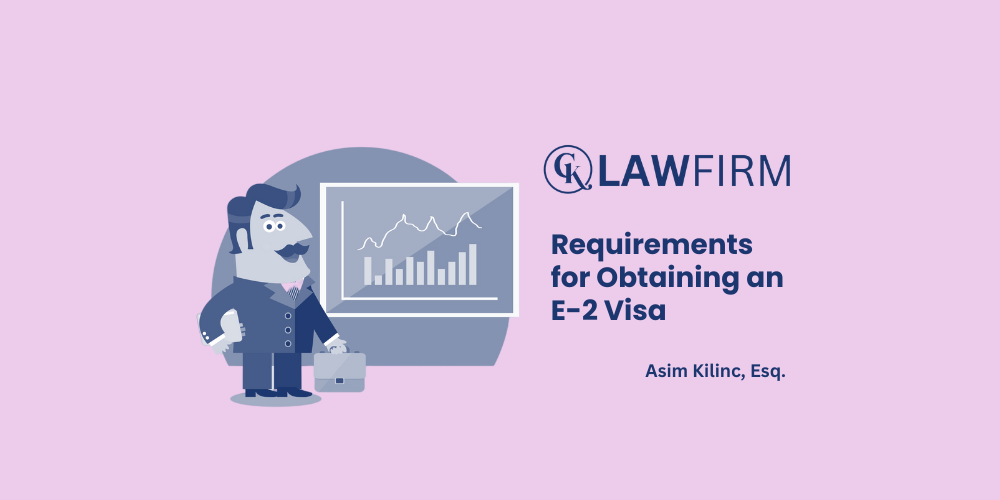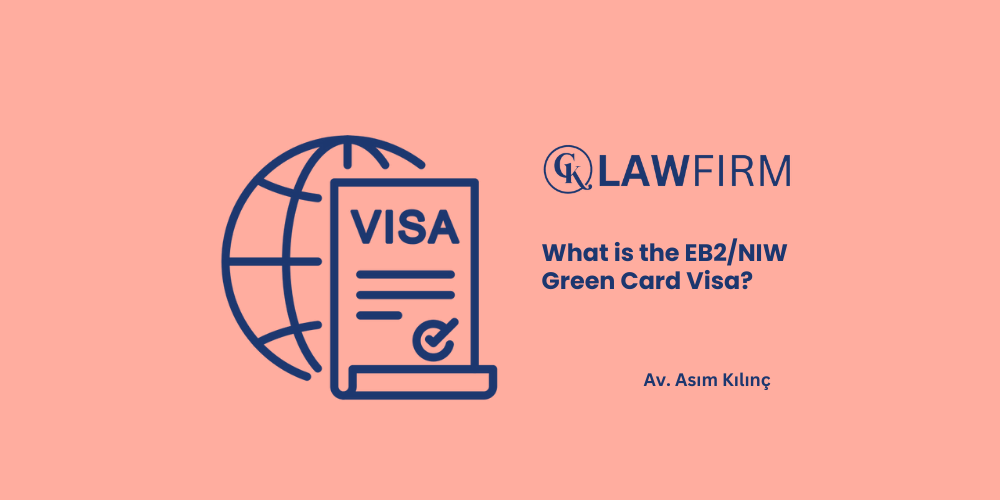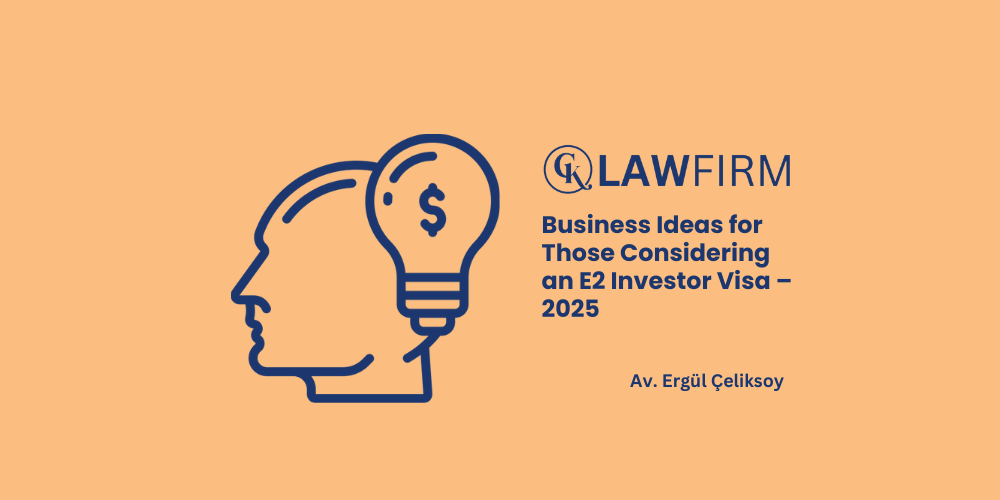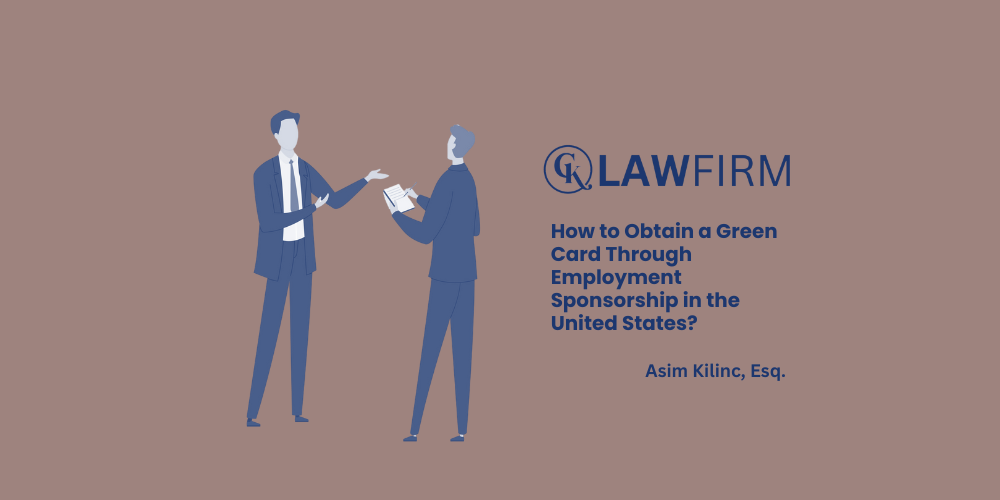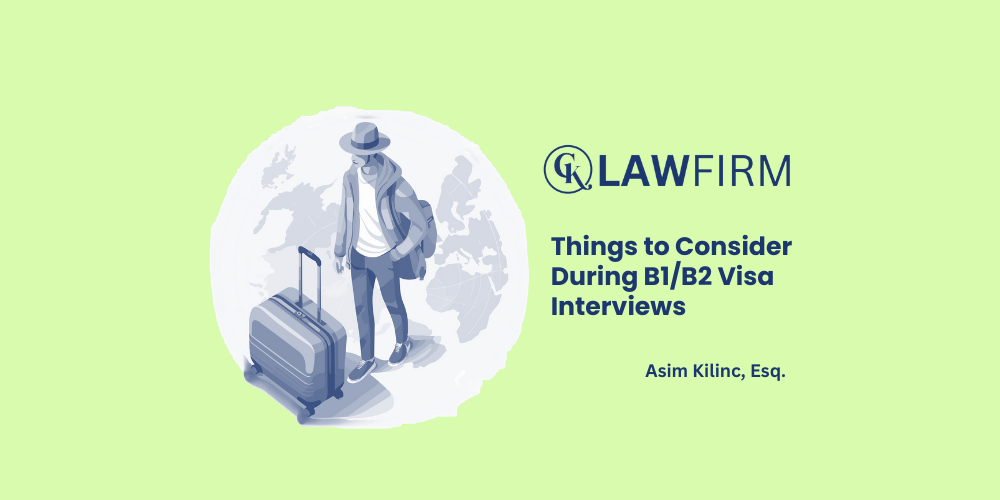Schedule an Appointment with Our Attorneys Now
By Asim Kilinc, Immigration Attorney at CK Law Firm
For millions of people dreaming of living and working permanently in the United States, the DV Lottery (Diversity Visa) offers a great opportunity. Organized annually by the U.S. government, this lottery gives applicants from all over the world a chance to win a Green Card. However, this process involves much more than just a simple lottery. By reading this article, you can find answers to the following questions:
- What is the DV Lottery?
- Who Can Apply for the DV Lottery?
- DV Lottery Application Process
- Steps to Follow After Winning the DV Lottery
- Living in the U.S. with the DV Lottery
If you have questions about the E2 Investor visa type besides these, please remember that you can contact me via the comments section below this article, directly through LinkedIn, or through the website of CK Law Firm, the Immigration Law Firm I co-founded!
What is the DV Lottery?
The Diversity Visa Lottery, commonly known as the DV Lottery, is a program organized annually by the U.S. government. This program offers individuals from certain countries the chance to gain permanent residency in the U.S., commonly known as a Green Card. Approximately 50,000 people win a Green Card through this lottery every year. The DV Lottery is aimed at citizens of countries that do not send many immigrants to the United States. This program aims to increase ethnic diversity in the U.S.
Who Can Apply for the DV Lottery?
To participate in the DV Lottery, the applicant’s place of birth must be in one of the eligible countries determined by the U.S. Additionally, applicants must have at least a high school education or have worked in a specialized job for at least two years within the last five years. Individuals who do not meet the education or work experience requirements cannot participate in the DV Lottery.
DV Lottery Application Process
- Online Application: Applications can only be submitted online through the official website of the U.S. Department of State. The application period usually begins in October and ends in November. During this time, the application form must be filled out carefully, and all required information must be provided completely.
- Required Information and Documents: During the application process, applicants are asked for personal information, educational background, place of birth, and current residential address. Additionally, a digital photo that meets the specified criteria must be uploaded. Entering incorrect or incomplete information may result in the application being considered invalid.
- Results Announcement: After applications are completed, winners are selected through a random lottery. Results are usually announced six months after the application period closes, typically in May. Applicants can check their results through the U.S. Department of State’s website. Winners must contact the U.S. Embassy to continue the Green Card application process.
Steps to Follow After Winning the DV Lottery
- Green Card Application Process: Those who win the DV Lottery must follow specific steps to obtain an entry visa to the U.S. and apply for a Green Card. These steps include gathering the necessary documents, undergoing medical examinations, and attending a consular interview. Completing each step carefully and on time is crucial for a successful application.
- Medical Examination and Police Records: During the Green Card application process, applicants must undergo certain medical examinations and present a clean police record before entering the U.S. These documents are submitted to U.S. authorities as part of the application process.
- Consular Interview: After all documents are collected, applicants are called for an interview at the U.S. Embassy. This interview is conducted to assess whether the applicant is eligible to immigrate to the U.S. During the interview, questions may be asked about the applicant’s plans for settling in the U.S., educational background, and work history.
- Visa Approval and Entry into the U.S.: Applicants who successfully pass the interview will receive the necessary immigrant visa to enter the U.S. After the visa is approved, applicants must enter the U.S. within a specified period and complete the Green Card application process shortly after entry.
Living in the U.S. with the DV Lottery
Winning the DV Lottery grants permanent residency and the right to work in the U.S. This opportunity provides a significant advantage in terms of establishing a new life, taking advantage of work and educational opportunities. However, there are important legal and logistical steps to consider throughout this process. After obtaining a Green Card, understanding the rights and responsibilities involved is critical to sustaining life in the U.S.
Conclusion
The DV Lottery offers a significant opportunity for those dreaming of living and working in the U.S. However, the application process and the steps that follow require careful attention. At CK Law Firm, we provide all the legal support you need during the DV Lottery application process and help you complete this process smoothly. We are by your side at every step of your application. Remember that you can reach out to me and my team through the CK Law Firm website, via info@cklawfirm.org email, or directly through LinkedIn!
Who is Lawyer Asım Kılınç?
Lawyer Asım Kılınç, as a founding partner of CK Law Firm, stands out with his mastery of both international law and the American legal system, gained through years of experience. Completing his Master’s degree at Southern Methodist University Dedman School of Law, Kılınç is registered with the Missouri Bar and specializes in U.S. immigration law. His deep knowledge and experience in immigration law have significantly contributed to CK Law Firm’s successes in this field. Having participated in the preparation processes of over 1,000 cases in immigration law, Lawyer Kılınç has proven his expertise in this field, providing comprehensive and professional legal support to his clients, facilitating their adaptation to their new lives in the U.S.
Strengthening CK Law Firm’s leadership in immigration law, Lawyer Kılınç offers reliable and effective legal consultancy services to his clients, standing by them in their journey to establish a new life in the U.S. He works to ensure that his clients receive the highest quality service in citizenship, Green Card, work permit, and other immigration processes, providing support to his clients throughout the entire process, from the beginning to U.S. citizenship.
By Asim Kilinc, Immigration Attorney at CK Law Firm
The E-2 visa presents a unique opportunity for entrepreneurs who wish to establish a business in the United States through investment. This visa type is available to citizens of countries that have trade agreements with the U.S., making it ideal for those who want to start a business or invest in an existing one in America. However, there are specific requirements that must be met to apply for this visa. In this article, I will discuss the necessary conditions for obtaining an E-2 visa. By the end of this article, you will find answers to the following questions:
- What is an E-2 Visa?
- Requirements for an E-2 Visa
- E-2 Visa Application Process
If you have any further questions about the E-2 Investor visa, please don’t hesitate to contact me through the comments section below, send me a message directly on LinkedIn, or reach out through the website of CK Law Firm, where I am a co-founder.
What is an E-2 Visa?
The E-2 visa is a temporary visa granted to citizens of countries that have trade agreements with the United States. This visa type is designed for entrepreneurs who wish to establish or invest in a business in the U.S. The E-2 visa allows the investor and their family to live and work in the United States. The visa duration can be renewed as long as the investment continues, offering entrepreneurs a long-term opportunity to stay in America.
Requirements for an E-2 Visa
Qualified Investor Status
The applicant must be a citizen of a country that has a trade agreement with the United States. This shows that the investment is based on the agreement with that country.
Substantial Capital Investment
The investment in the U.S. must be significant in size. The amount of capital required may vary depending on the type and size of the business, but it must be sufficient to make the business operational and sustainable. The key is that the investment must be actively operating and not just on paper.
Active Business and Management
The investor must actively manage the business they are investing in and participate in the day-to-day operations. The E-2 visa is not suitable for passive investors. The investor must maintain control of the business and manage its operations.
Real and Commercially Viable Investment
The investment must be made in a real business and be commercially viable. The investment is expected to contribute to the American economy, not just for profit. For example, speculative or real estate investments do not fall under this category.
Sustainability and Business Plan
The investment must be structured to support not only the investor but also the American workforce. The business must employ American citizens and Green Card holders. The business plan must detail how the investment will succeed, requiring a solid business plan and projections that demonstrate the long-term viability of the business.
Irrevocable Investment
The investment must not be a recoverable investment. In other words, the invested capital must be at risk depending on the success of the business. This demonstrates that the investment is serious and permanent.
Temporary Stay
The E-2 visa grants the investor the right to stay temporarily in the U.S., with the possibility of renewal as long as the business continues. However, the E-2 visa does not provide permanent residency status.
Family Members
The spouse and children under 21 of an E-2 visa holder are also allowed to live and work in the United States. Spouses can work in any job, and children can continue their education. This ensures the unity of the family.
E-2 Visa Application Process
Preparation of a Business Plan
Before applying for an E-2 visa, a detailed business plan must be prepared. This plan should explain how the investment will be made, how the business will be managed, and how sustainability will be ensured. The business plan is a crucial document to convince the U.S. government that the investment is serious and viable.
Preparation of Application Documents
The necessary documents for the visa application must be meticulously prepared. These documents include financial details of the investment, the business plan, evidence that the investor will play an active role in the U.S. business management, and other supporting documents.
Consular Interview
After the application, the investor must attend an interview at the U.S. Consulate. During this interview, the investor will be asked questions about the business plan and investment details. The investor is expected to prove their active role in managing the business and the sustainability of the investment.
Visa Approval and Entry to the U.S.
After the interview, if the E-2 visa is approved, the investor can enter the U.S. and start or take over their business. The visa duration can be renewed depending on the sustainability of the investment and business.
Conclusion
The E-2 visa offers significant opportunities for entrepreneurs who want to start or invest in a business in the United States. However, to successfully complete this process, detailed preparation, a meticulous business plan, and the active involvement of the investor in business management are essential. Given the complexity of the process and legal requirements, seeking support from an immigration attorney can be beneficial. Don’t hesitate to contact me through the CK Law Firm’s website, via email at info@cklawfirm.org, or directly on LinkedIn!
Who is Lawyer Asım Kılınç?
Lawyer Asım Kılınç, as a founding partner of CK Law Firm, stands out with his mastery of both international law and the American legal system, gained through years of experience. Completing his Master’s degree at Southern Methodist University Dedman School of Law, Kılınç is registered with the Missouri Bar and specializes in U.S. immigration law. His deep knowledge and experience in immigration law have significantly contributed to CK Law Firm’s successes in this field. Having participated in the preparation processes of over 1,000 cases in immigration law, Lawyer Kılınç has proven his expertise in this field, providing comprehensive and professional legal support to his clients, facilitating their adaptation to their new lives in the U.S.
Strengthening CK Law Firm’s leadership in immigration law, Lawyer Kılınç offers reliable and effective legal consultancy services to his clients, standing by them in their journey to establish a new life in the U.S. He works to ensure that his clients receive the highest quality service in citizenship, Green Card, work permit, and other immigration processes, providing support to his clients throughout the entire process, from the beginning to U.S. citizenship.
For skilled individuals seeking permanent residency in the United States, the EB2/NIW Green Card visa presents a significant opportunity. This visa category, under the EB2 classification, is specifically designed for individuals with exceptional abilities or those who can contribute to the national interests of the U.S. But what exactly is the EB2/NIW visa, and who is eligible to apply? Here are the topic that we will discuss:
- What is the EB2/NIW Visa?
- Who is Eligible for the EB2/NIW Visa?
- Professions Eligible for the EB2/NIW Visa
- Professions Eligible for the EB2/NIW Visa
- EB2/NIW Visa Application Process
- Benefits of the EB2/NIW Visa
- EB2/NIW Green Card Application and Transition Process
- EB2/NIW Visa Costs and Fees
In this article, you can find answers to your questions about the topics mentioned above. However, if you have any other questions, feel free to ask them in the comments section of this blog or reach out to us through our website. Additionally, for inquiries on different topics, you can contact me via LinkedIn.

What is the EB2/NIW Visa?
The EB2/NIW visa (Employment-Based Second Preference – National Interest Waiver) is an immigrant visa category that allows highly skilled individuals to live and work in the U.S. The “National Interest Waiver” (NIW) eliminates the requirement for employer sponsorship, allowing applicants to obtain a Green Card without needing a job offer.
This visa is particularly suitable for scientists, engineers, doctors, academics, entrepreneurs, and professionals in specialized fields. Applicants must demonstrate that their contributions will benefit the U.S. economy, healthcare, education, or technology sectors.
Who is Eligible for the EB2/NIW Visa?
This visa category is ideal for:
- Individuals with advanced degrees (at least a master’s degree or equivalent work experience)
- Professionals with significant achievements in their field
- Individuals whose work is considered beneficial to U.S. national interests
Professions Eligible for the EB2/NIW Visa
Certain professions are particularly well-suited for EB2/NIW visa applications, including:
- Scientists and Researchers: Experts contributing to scientific advancements in the U.S.
- Engineers and Technology Specialists: Professionals involved in innovative projects
- Doctors and Healthcare Professionals: Individuals making critical contributions to healthcare
- Academics and Educators: Those enhancing the U.S. education system
- Entrepreneurs and Business Leaders: Innovators contributing to the U.S. economy
- Pilots: Experienced pilots may apply, considering the U.S. aviation sector’s demand for skilled professionals. Applicants must demonstrate how they contribute to national air safety and transportation infrastructure.
EB2/NIW Visa Application Process
The application process for an EB2/NIW visa consists of the following steps:
- Eligibility Assessment: Reviewing academic background, work experience, and achievements.
- Providing NIW Evidence: Submitting supporting documents such as recommendation letters, research publications, and proof of contributions.
- Filing Form I-140: Submitting the petition to U.S. Citizenship and Immigration Services (USCIS).
- Applying for a Green Card: Once approved, applicants proceed with status adjustment or consular processing.
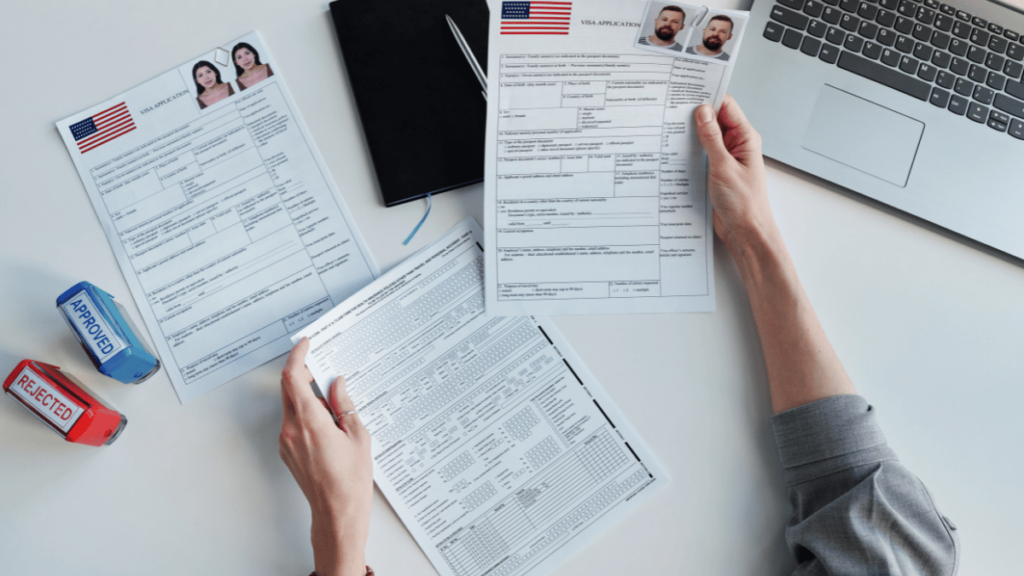
Benefits of the EB2/NIW Visa
- No Employer Sponsorship Required: Applicants can apply without employer support.
- Direct Path to a Green Card: Approval leads to permanent residency.
- Work and Live in the U.S.: A great opportunity for highly skilled individuals.
- Residency for Spouse and Children: Family members also receive residency rights.
EB2/NIW Green Card Application and Transition Process
The EB2/NIW visa is one of the key steps in obtaining a Green Card. After the application process is completed, the following stages are followed:
Form I-140 Approval: The application must be accepted by USCIS.
Visa Number Availability: A visa number must become available according to the annual quota set by the U.S. Citizenship and Immigration Services (USCIS).
Form I-485 or Consular Processing:
- If you are inside the U.S., you can change your status with Form I-485.
- If you are outside the U.S., you can complete the Green Card application through the nearest U.S. consulate.
Interview and Final Processing: You may be called for an interview by USCIS or consular officials.
Green Card Approval and Delivery: Once all steps are successfully completed, your Green Card is printed and sent to your address.
EB2/NIW Visa Costs and Fees
The total cost of an EB2/NIW application varies depending on legal services and application requirements. However, basic costs include:
- I-140 Petition Fee: $700
- Green Card Processing Fees: Approximately $1,140
The EB2/NIW Green Card visa provides a great advantage for skilled professionals who wish to live in the U.S. without employer sponsorship. If you hold an advanced degree, have expertise in your field, and can make significant contributions to the U.S., this visa may be an excellent option for you.
To learn more about the EB2/NIW visa and start your application process, consulting an immigration attorney is highly recommended! If you have any questions in mind, you can contact us through our website. Additionally, you can always reach out to me directly via my LinkedIn account for one-on-one communication.
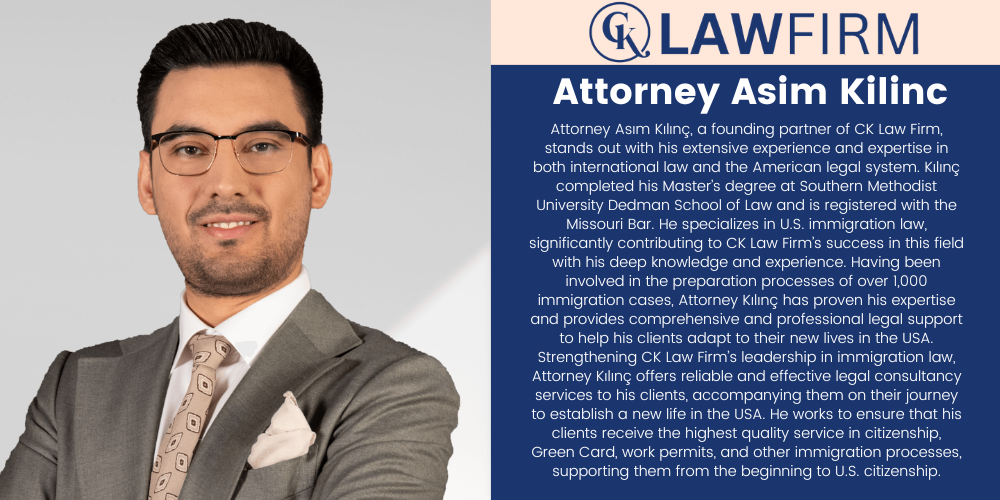
By Ergul Celiksoy, Immigration Attorney at CK Law Firm
If you want to start your own business and live in the United States, the E2 investor visa could be an ideal option for you. The E2 visa allows citizens of countries that have a trade agreement with the U.S. to establish and operate a business by making a substantial capital investment. There are many different sectors and business opportunities available for investors who wish to move to the U.S. through the E2 visa. In this article, we will provide information on E2 visa business ideas, investment amounts, and the application process to help you successfully start a business in the United States.
Below are the key topics we will cover:
- What is an E2 Visa?
- Business Ideas You Can Start in the U.S. with an E2 Visa
- Advantages of Starting a Business in the U.S. with an E2 Visa
If you have any further questions or want to explore more, feel free to visit our website. For personalized inquiries, you’re always welcome to connect with me on LinkedIn. Enjoy reading!
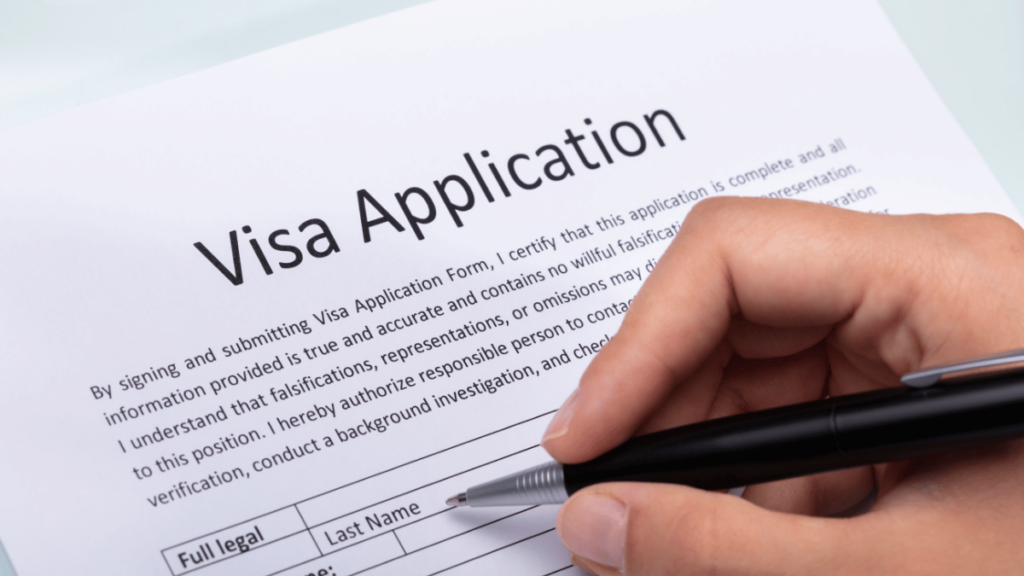
What is an E2 Visa?
The E2 investor visa allows investors to live and manage a business in the United States by making a significant capital investment in a U.S.-based company. However, this visa does not directly provide a green card; as long as the investor continues to operate their business, the visa can be renewed.
There is no fixed fee for the E2 visa, but the application process may involve legal fees and other costs. The typical investment amount for an E2 visa ranges between $100,000 and $200,000, although in some cases, lower investments may also be accepted.
Business Ideas You Can Start in the U.S. with an E2 Visa
There are various business opportunities available for those considering establishing a business in the U.S. through the E2 visa. Here are some promising E2 visa business ideas for 2025:
1. Franchise Businesses
Purchasing a franchise is one of the safest options for the E2 visa. Well-known franchises such as Subway, and 7-Eleven are attractive for investors. Franchise systems typically provide a proven business model, reducing the risk of failure for investors.
2. E-Commerce and Online Stores
E-commerce businesses, such as Amazon FBA, Shopify stores, or private-label products, are gaining popularity due to their low startup costs. Focusing on a niche product can be a profitable way to enter the U.S. market.
3. Restaurant and Café Businesses
The food and beverage sector is always in demand in the U.S. Organic food restaurants, vegan cafés, or restaurants specializing in Turkish cuisine are particularly popular. With a successful restaurant concept, you can reach a large customer base in major cities.
4. Automotive Sector: Car Rental or Car Wash Businesses
Car ownership is widespread in the U.S., making car rental or car detailing services profitable business ideas. In particular, electric vehicle charging stations or mobile car wash services are expected to have significant potential in 2025.
5. Digital Marketing Agency
Many small businesses in the U.S. need support with social media management and digital marketing. You can establish an agency specializing in SEO, social media advertising, or content marketing to offer services to these businesses.
6. Beauty and Personal Care Services
Hair salons, spas, and skincare clinics hold a significant market share in the U.S. Opening a beauty center that offers the latest trends and technologies can be particularly successful in large metropolitan areas.
7. Education and Consulting Services
Offering English language instruction to non-native speakers, career counseling, or software training can provide high-profit margins with low startup costs.

Advantages of Starting a Business in the U.S. with an E2 Visa
- Pathway to a Green Card: Although the E2 visa does not directly provide a green card, successfully operating and expanding a business can facilitate the transition to other investment visas like the EB-5.
- Work Authorization for Family Members: The spouses of E2 visa holders can obtain work authorization, and their children can access the U.S. education system.
- Unlimited Visa Renewals: As long as the business remains active, the E2 visa can be renewed indefinitely.
There are numerous business opportunities available for those considering starting a business in the U.S. with an E2 visa. Profitable E2 visa business ideas include franchise operations, e-commerce, restaurants, the automotive sector, and digital marketing agencies. If you aim to establish a successful business in the U.S. through the E2 investor visa, preparing a solid business plan and securing the necessary capital will be key steps for a successful application.
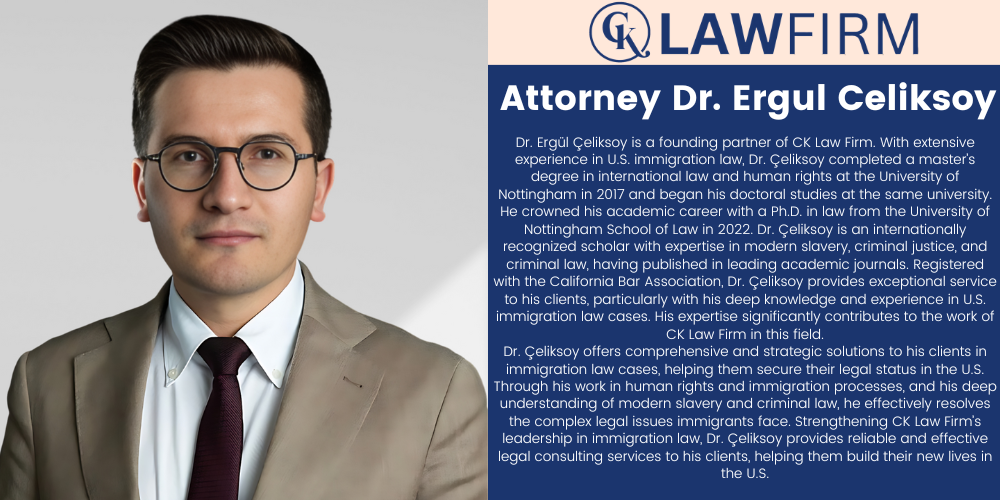
By Asim Kilinc, Immigration Attorney at CK Law Firm
Obtaining a Green Card, which grants permanent residency and work rights in the United States, is a significant opportunity for many immigrants. While there are various paths to obtaining this card, employment sponsorship is one of the most common and reliable methods. Securing a Green Card through employment sponsorship follows a specific procedure, and there are many critical points to consider throughout this process. In this article, we will thoroughly examine all the stages of obtaining a Green Card through employment sponsorship and the keys to success in this process:
- What is Employment Sponsorship and Green Card?
- The Basic Steps to Obtaining a Green Card Through Employment Sponsorship
- Important Considerations in Employment Sponsorship
If you have any additional questions, please do not hesitate to reach out to me directly through LinkedIn, via the comment section below this article, or through our CK Law Firm Immigration Law Firm’s website!
What is Employment Sponsorship and Green Card?
What is Employment Sponsorship?
Employment sponsorship is when an American employer supports a foreign employee’s application for a Green Card. The employer must apply to the U.S. Department of Labor, proving that the position cannot be filled by a resident citizen in the U.S. This sponsorship is typically carried out under work visas such as EB-2 and EB-3.
What is a Green Card?
A Green Card is a document that grants the holder permanent residency and work rights in the United States. Green Card holders can live, work, and study anywhere in the U.S. Additionally, after fulfilling certain requirements, Green Card holders may apply for U.S. citizenship.
For more detailed information about Green Cards, you can check out this article!
The Basic Steps to Obtaining a Green Card Through Employment Sponsorship
PERM (Program Electronic Review Management) Process:
This process involves the employer applying for a labor certification from the U.S. Department of Labor. To obtain this certification, the employer must demonstrate that a specific position cannot be filled by American workers. This includes steps such as posting job advertisements and conducting interviews with potential candidates. The employer must prove that no suitable American citizen was found for the job.
I-140 Immigrant Petition:
After completing the PERM process, the employer submits an I-140 Immigrant Petition to USCIS. This petition indicates that the employer intends to hire the foreign employee permanently and that the employee possesses the necessary qualifications. Once the I-140 petition is approved, the employee can proceed with the Green Card application.
c. Green Card Application:
After the I-140 petition is approved, the employee can apply for a Green Card in two ways:
- I-485 Adjustment of Status Application: If the employee is already in the U.S., they can apply to adjust their status to a Green Card using Form I-485.
- Consular Processing: If the employee is abroad, they can start the Green Card process by applying at their local U.S. consulate.
Important Considerations in Employment Sponsorship
Employer’s Reliability and Financial Status
USCIS considers the financial stability and sustainability of the employer. The employer must have the financial strength to ensure the long-term employment of the employee. Financial documents, tax returns, and business plans are crucial in this process.
Employee’s Qualifications and Experience
The employee’s qualifications play a significant role in the employment sponsorship process. The employer must prove that the employee possesses all the qualifications required for the position. These qualifications include education, professional experience, and special skills. Especially for the EB-2 visa, the employee must have advanced education or exceptional ability in their field.
For more detailed information on the EB-2 visa, you can check out our blog!
Successful Completion of the PERM Process
The PERM process is one of the most critical steps in obtaining a Green Card through employment sponsorship. The employer must post job advertisements on appropriate platforms and complete the application process meticulously. The accuracy of all information provided during the application and the completeness of the documents are of great importance.
Length of the Green Card Application Process and Time Management
The Green Card application process can be lengthy and complex. Time management and careful monitoring of application steps are essential during this process. The employee and employer must take each step of the application process on time to avoid rejection. Especially tasks like collecting documents, filling out forms, and paying application fees must be completed promptly.
For applications made from abroad, the interview conducted at the local U.S. consulate is of great importance. During the interview, the candidate must clearly express their intent to live and work permanently in the U.S. Consular officers will review all the candidate’s documents, and if any incorrect or missing information is found, the application may be denied.
Conclusion
Obtaining a Green Card through employment sponsorship in the U.S. is a lengthy process that requires meticulous attention. An application supported by accurate information and documents increases the chances of a successful outcome. Factors such as the employer’s financial status, the employee’s qualifications, the successful completion of the PERM process, and time management are the cornerstones of this process. Since the process of obtaining a Green Card through employment sponsorship is complex and lengthy, the guidance of an experienced immigration attorney is invaluable at every step. Due to the complexity of the process and legal requirements, it may be beneficial to seek assistance from an immigration attorney. Please remember that you can reach me directly through LinkedIn, via email at info@cklawfirm.org, or through our CK Law Firm Immigration Law Firm’s website!
Who is Lawyer Asım Kılınç?
Lawyer Asım Kılınç, as a founding partner of CK Law Firm, stands out with his mastery of both international law and the American legal system, gained through years of experience. Completing his Master’s degree at Southern Methodist University Dedman School of Law, Kılınç is registered with the Missouri Bar and specializes in U.S. immigration law. His deep knowledge and experience in immigration law have significantly contributed to CK Law Firm’s successes in this field. Having participated in the preparation processes of over 1,000 cases in immigration law, Lawyer Kılınç has proven his expertise in this field, providing comprehensive and professional legal support to his clients, facilitating their adaptation to their new lives in the U.S.
Strengthening CK Law Firm’s leadership in immigration law, Lawyer Kılınç offers reliable and effective legal consultancy services to his clients, standing by them in their journey to establish a new life in the U.S. He works to ensure that his clients receive the highest quality service in citizenship, Green Card, work permit, and other immigration processes, providing support to his clients throughout the entire process, from the beginning to U.S. citizenship.
By Asim Kilinc, Immigration Attorney at CK Law Firm
The B1/B2 visa is one of the most common types of visas applied for by those wishing to travel to the United States for business or tourism purposes. The visa interview is one of the most critical stages that will determine whether your application is accepted. In this article, we will touch on the important points to be aware of during the B1/B2visa interview:
- Be Prepared with the Correct Documents
- Honesty and Consistency
- Present Evidence Supporting Your Return
- Choose Appropriate Attire for the Interview
- Clearly State the Purpose of Your Visa
- Financial Adequacy
- Prepare in Advance
- Documents Supporting Your Travel Plans
If you have any further questions regarding the B1/B2 visa type, please don’t hesitate to contact me via the comments section at the bottom of this article, by sending a direct message on LinkedIn, or through the website of CK Law Firm, where I am a co-founder.
Be Prepared with the Correct Documents
It is crucial to present complete and accurate documents during the B1/B2 visa interview. Consular officers may request the following documents from you:
- Passport: A passport valid for at least six months from the date of travel.
- DS-160 Form Confirmation Page: The completed and approved online application form.
- Visa Appointment Confirmation Document: The document showing your interview appointment.
- Financial Documents: Bank statements, pay stubs, letters from your employer.
- Previous Visas and Passports: If applicable, old passports and previous visas.
Honesty and Consistency
Being honest and providing consistent information during the interview is extremely important. If the consular officer detects any inconsistencies in the information you provide, your application may be denied. You should give clear and direct answers to the questions and avoid making any false statements.
Present Evidence Supporting Your Return
You need to prove during the interview that you only intend to go to the United States for a temporary period. To prove your intention to return to your country, you can:
- Employment Status: A letter of leave from your current employer or projects that require your return.
- Financial Situation: Documents showing your financial status in Turkey, your properties, and investment accounts.
- Family Ties: Documents showing your ties with your spouse, children, or other close relatives.
Choose Appropriate Attire for the Interview
Wearing formal and simple attire shows the seriousness of the interview. You should dress carefully to leave a positive first impression on the consular officer. Without going overboard, make sure to appear clean and well-groomed.
Clearly State the Purpose of Your Visa
The consular officer will want to know why you want to go to the United States. Clearly explain the purpose of your trip. Are you going for a business trip? What events will you attend? If you are going for tourism, specify the places you plan to visit and how long you intend to stay.
Financial Adequacy
You will need to show how you will cover your expenses during your stay in the United States. Bank statements or sponsorship documents play an important role in this phase. Proving that you have sufficient financial resources will contribute to a positive outcome for your visa application.
Prepare in Advance
Preparing for possible questions in advance will increase your confidence during the interview. Study the frequently asked questions and practice your answers. Be ready for questions such as “How long do you plan to stay in the United States?” or “Have you ever applied for a visa before?”
For more information about U.S. visa interviews, you can check out this article!
Documents Supporting Your Travel Plans
Providing documents that support your travel purpose and duration can be helpful during the interview. Airline ticket reservations, hotel reservations, or documents related to the events you will attend should confirm your travel plans.
Conclusion
The B1/B2 visa interview is one of the most important steps in obtaining a visa. Careful preparation and an honest approach will help you have a successful interview. By following this guide, you can increase your chances of getting a positive result on your visa application. Additionally, don’t forget that you can reach me directly through the CK Law Firm Immigration Law Firm website, via email at info@cklawfirm.org, or on LinkedIn!
Attorney Asim Kilinc
Attorney Asım Kılınç, a founding partner of CK Law Firm, stands out with his extensive experience and expertise in both international law and the American legal system. Kılınç completed his Master’s degree at Southern Methodist University Dedman School of Law and is registered with the Missouri Bar. He specializes in U.S. immigration law, significantly contributing to CK Law Firm’s success in this field with his deep knowledge and experience. Having been involved in the preparation processes of over 1,000 immigration cases, Attorney Kılınç has proven his expertise and provides comprehensive and professional legal support to help his clients adapt to their new lives in the USA.
Strengthening CK Law Firm’s leadership in immigration law, Attorney Kılınç offers reliable and effective legal consultancy services to his clients, accompanying them on their journey to establish a new life in the USA. He works to ensure that his clients receive the highest quality service in citizenship, Green Card, work permits, and other immigration processes, supporting them from the beginning to U.S. citizenship.
Subscribe to Our Newsletter
Subscribe to our newsletter to stay informed about the latest announcements and articles written by our attorneys on U.S. immigration processes.
Aout Us
Our experienced lawyers at CK Law Firm offer effective solutions for those who want to make new beginnings in the USA. We facilitate and accelerate your immigration process by providing consultancy on all visa types.
Our Services
Visas
Business Green Card
Family Green Card
US Citizenship
Talent and Performance Visas
Work Visas
Investor and Trader Visas
Contact Us
+1 (972) 363- 96 89
info@cklawfirm.org
Address
2800 Regal Rd #102, Plano, TX 75075

All Rights Reserved by CK Law Firm.



